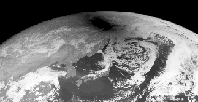J. Brit. Astron. Assoc., 107, 3, 1997, pp. 112-113
 The unusually elongated shadow of the Moon on 1997 March 9 is clearly seen in this image from the NASA GMS-5 weather satellite. (NASA/NOAA)
The unusually elongated shadow of the Moon on 1997 March 9 is clearly seen in this image from the NASA GMS-5 weather satellite. (NASA/NOAA)
The track of the 1997 March total eclipse covered a wide swathe of Mongolia, Russia and arctic China. Fortunes for observers were mixed: while most of those who travelled to Mongolia were clouded out, Chita in Siberia and Mo He in northern China had clear skies.
Our group of 218 mainly British and European observers drove overnight in eight buses from Ulaan Baatar to the northern industrial city of Darhan. We stopped once along the way to see comet Hale-Bopp from a totally dark site: although impressive, the comet was not as sharp and clear as it should have been, and the stars were hazy. Within an hour we were driving through falling snow. At first light the snow had stopped and it seemed possible the cloud was breaking up behind the front, so we moved on quickly northwards towards the Russian border. The front two buses kept going until 10 minutes before second contact, but the others dropped out sooner behind us.
We finally stopped on the side of the road overlooking a vast, empty treeless landscape of rolling hills and thin, snow-covered grass. With the partial phase of the eclipse well advanced the sky appeared dark and overcast, but ridges of cloud were blowing across quite fast, and between the cloud were clearer patches. Soon we saw it was a race between a particular clear patch and the inexorable passage of the Moon.
The edge of the cloud became golden in the rapidly diminishing sunlight, and the finest sliver of crescent Sun broke through above us. Second contact came almost immediately, with a flash of diamond ring and cheers from the exhilarated spectators. Despite the remaining cloud we could see the corona clearly. This was remarkable for its difference from the two previous eclipses (1994 November and 1995 October) which both showed the classic east-west streamers of solar minimum. This time the corona appeared evenly circular, with one stubby spike at about seven o'clock (southeast), and a wide 'helmet' on the right hand side (southwest). Unfortunately due to cloud, the structure and the outer corona could not be fully seen. The temperature at the site was measured at -8°C, with negligible breeze at ground level, but fast winds pushing the clouds across the sky above us. The eclipse was very dark compared with recent experience.
All too soon a shimmer of pink at the top right proclaimed the imminent end of totality. Third contact brought a broken ring of Baily's Beads, followed instantly by the golden crescent, and almost immediately the clouds blew over and again covered the Sun. Returning to Darhan for breakfast we met the remainder of the group and found out how lucky we had been. Strung out along the road, some had seen the corona very briefly and then third contact; most had seen only cloud, with the gap arriving at their location a few minutes after the eclipse was over.
Return to Journal 1997 June contents page